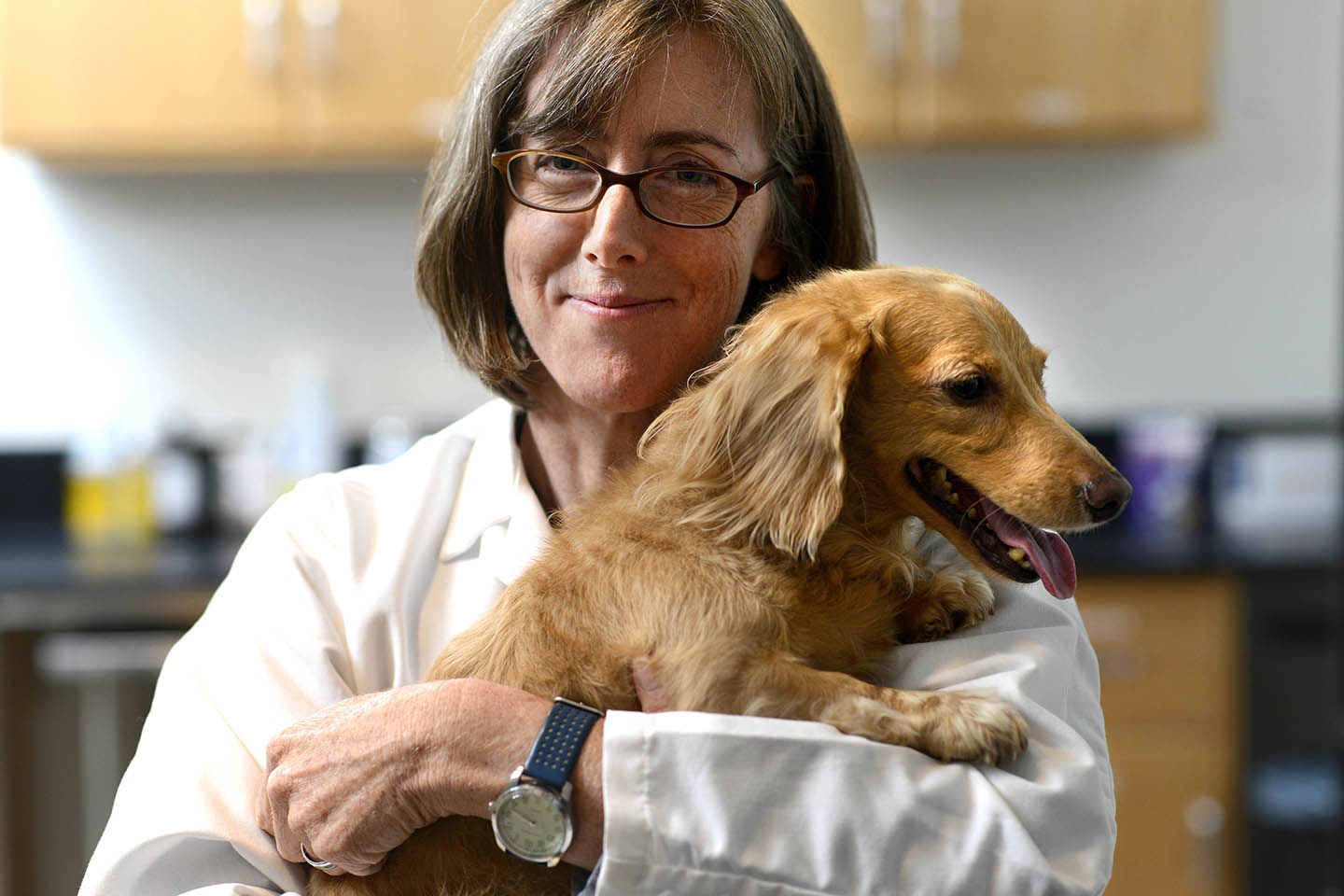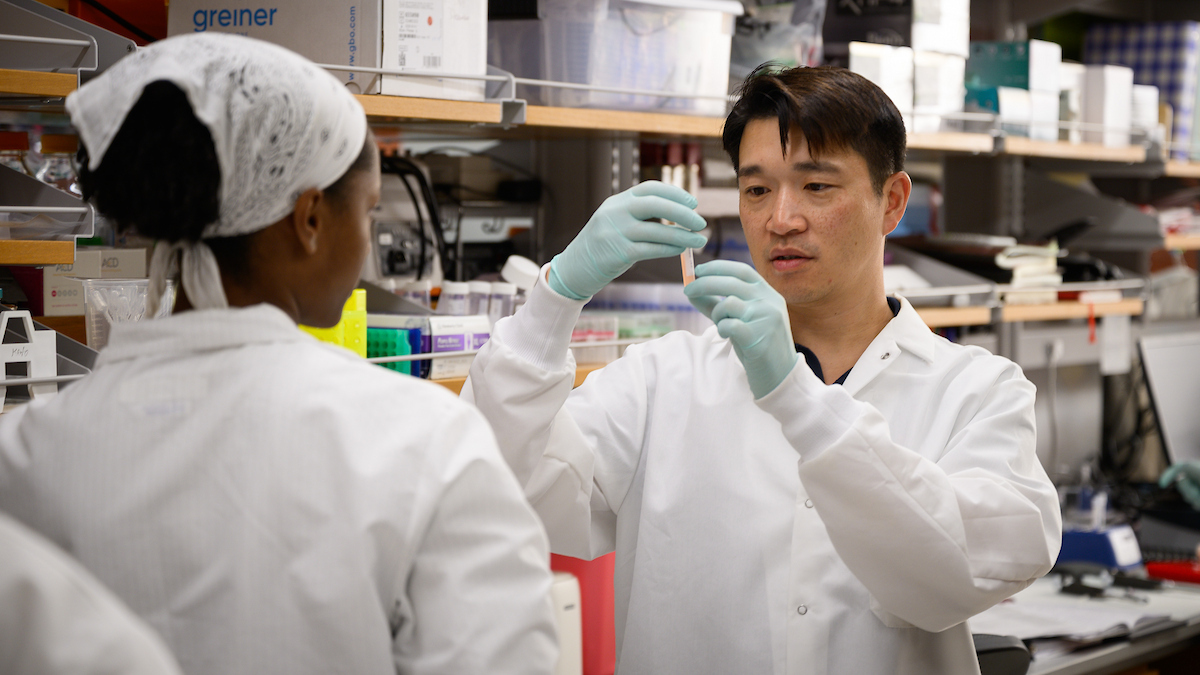On the Move: Dr. Natasha Olby

Veterinary neurologist Natasha Olby carries Reagan, a plush golden dachshund, into a treatment room in NC State’s cutting-edge veterinary hospital. The dog shyly eyes a visitor while Olby sets the animal on an exam table and carefully manipulates his back legs.
Reagan seems perfectly content throughout the exam, and his instincts aren’t wrong. He couldn’t be in better hands.
“The most common condition we neurologists see is dogs with spinal cord injuries,” Olby says as she checks Reagan’s posture. “That’s why I just love my spinal cord injury research.”
Advances in veterinary neurology are coming quickly now after years of research —and Olby is delighted to be at the forefront of discovery.
Although spinal injuries can be painful and debilitating, they often respond well to surgery and rehabilitation. But in some cases, a dog with a spinal injury may suffer permanent paralysis, especially if the nerves in the spinal column are severely damaged.
“There’s a lot of energy and attention focused on the acute phase right after an injury,” she explains. “But after a couple of weeks, guess what? If they haven’t gotten better, they’re going into a chronic phase, and we don’t have great options for treatment then.”

Olby focuses much of her research on expanding those treatment options, giving her canine patients better odds of living rewarding, active lives. She ticks off some of the more promising areas of research, including epidural stimulation of the spinal cord, Schwann cell transplantation to regenerate nerve fibers and use of the drug 4-Aminopyridine to restore the conduction of impulses across regions of nerve fibers that have lost their myelin, a natural insulating material.
All of these research areas are important because, as Olby demonstrated in a recent clinical trial, dogs with the same type of injury often respond very differently to the same treatment.
“If we take a group of dogs with acute spinal cord injuries due to a herniated disc and look at their spines using an MRI, some of them have what looks like fibrous scar tissue in there, and some of them have a big fluid-filled hole,” she says. “Some of them may even have demyelination that we can’t see with a regular MRI. It’s complicated.”
Olby takes a holistic approach, targeting virtually everything related to her patients’ paralysis — even conditions that have nothing to do with neurology.
“We look at secondary health problems, such as urinary tract infections, that paralyzed dogs tend to get,” she says. “For example, we’ve just done a clinical trial of cranberry extract to see if it reduces those infections.”
Olby’s work is the essence of personalized medicine, caring for individual patients with medical strategies tailored to their physical characteristics and genetic predisposition to respond to treatment.
If you’re wondering why you can’t get this level of care from your family doctor, don’t worry. It’s only a matter of time. Dogs like Reagan are excellent models for people, she explains.
That brings us to another of Olby’s research areas: neurogenetics, a field at the intersection of neuroscience and genetics that explores how an animal’s genetic code affects its physical traits. The connection to human health is striking. Olby studies hereditary ataxias, a group of diseases found in some breeds of dogs, which are also among the most common neurodegenerative disorders in humans.
Ataxia occurs when a gene makes abnormal proteins that impede the function of nerve cells, primarily in the cerebellum and spinal cord, causing them to degenerate. Over time, sufferers have trouble walking and may experience a wide range of symptoms, such as slurred speech, fatigue, involuntary eye movements, curvature of the spine, hearing loss and even heart disease.
While you probably haven’t heard of ataxias, these diseases are almost as prevalent as better-known neurological disorders such as Huntington’s and Parkinson’s. They’re also extremely difficult to treat. Just finding the genetic mutations linked to each type of ataxia is like finding the proverbial needle in a haystack.
However, because dogs have been narrowly bred over millennia, ataxia mutations in their genes are easier to spot. That’s exactly what happened last February when Olby and a team of researchers identified a mutation related to a type of hereditary ataxia in the genes of Old English sheepdogs and Gordon setters.
It was a groundbreaking moment.
“Identifying the mutation helps us understand what is killing neurons and may enable us to develop a therapy that is going to be pertinent to people with neurodegenerative diseases,” she says. “Once you understand what causes the disease, then you can start to look at new ways to treat it. That’s the potential.”
Olby recognized her own potential as a veterinarian at an early age. Raised in the Yorkshire region of England, she was inspired by the semi-autobiographical books chronicling the day-to-day struggles and triumphs of Yorkshire veterinary surgeon James Herriot, starting with the 1972 bestseller All Creatures Great and Small.
“There’s a whole generation of people who wanted to be vets because of James Herriot,” she says. “I was one of them.”
Years later, Olby’s dream took shape at the University of Cambridge, where she pursued a degree in veterinary medicine and a Ph.D. in neurosciences. Her decision to pursue neurosurgery as a specialty came in a roundabout way.
“I joined a rowing team,” she explains. “I spent many hours every day rowing and decided that I wanted to further my rowing career.”
But the team’s schedule threatened to interfere with her schoolwork. Luckily, Olby stumbled upon a lab at the university that offered to accommodate her passion for rowing.
“The professor said, ‘If you want to row, I’ll let you row and work in my lab.’ It happened to be a neurology lab that focused on spinal cord injuries,” Olby says. “It turned out to be perfect for me.”
Why was the professor so eager to help the young student? “He was the treasurer of the local rowing club,” Olby explains with a grin.
Now that she’s midway through a rewarding and successful career as a veterinary neurologist, Olby knows she picked the right specialty, even if by happenstance.
“This is a really exciting time in the field,” she says. “Here in my lab we have a lot of clinical trials under our belt, so we know how to do them well, and we can get funding to do them. Best of all, we’re starting to turn out some really useful data.”
For dogs like Reagan — and thousands of people with spinal cord injuries — Olby hopes to translate those research findings into new knowledge leading to better medical care.
As for her passion for rowing?
“I never did become a rowing superstar,” Olby deadpans. “I got trapped into neurology instead.”
**This article was written by David Hunt for Results Magazine PDF version available here.


